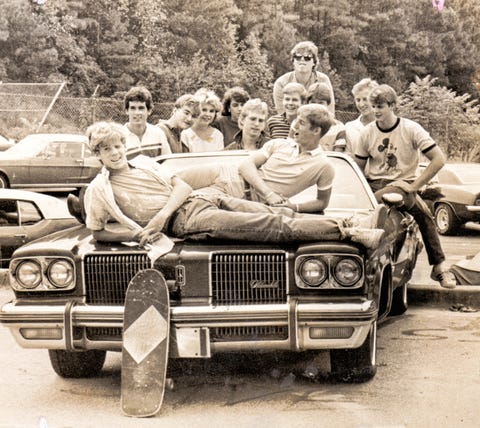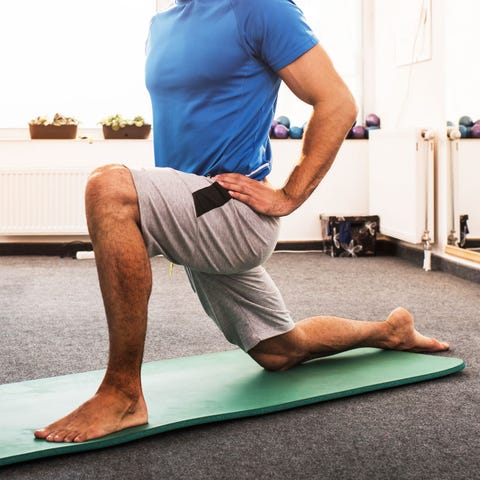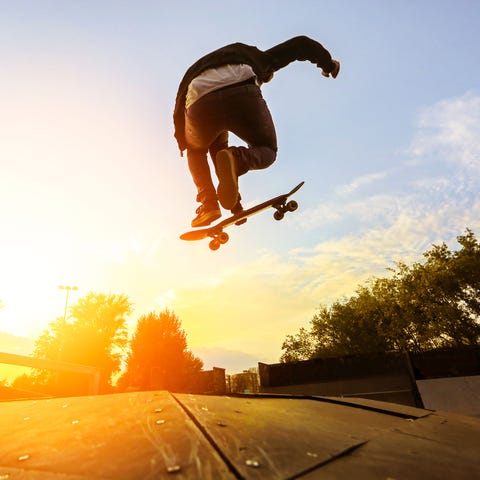
As I lie on the driveway between my front stairs and the quarter pipe my nine-year-old son, Fritz, and I built last year, replays of my greatest hits of skateboarding over the past 30 years flash before my eyes. Back when I was 20, at what you might call “peak skate,” I could lay out a stylish frontside or backside turn on any curved transition; boost an ollie onto and off of, say, a park bench; rail slide along a parking barrier for ten feet without much drama. Skating—and skaters—rescued me from the stifling southern suburban realm that defined my young existence. From trips with friends to ramp-jam contests and concrete ditches to deafening (and bruising) concerts by the Dead Kennedys or Black Flag, skateboarding was central in my physical and social life. Skating wasn’t something I did; it was who I was. I simply loved it. And aside from the occasional wrist sprain, broken toe, or bout of tinnitus, skating loved me back.

One aspect of fatherhood I’d always gleefully anticipated was the simple joy of teaching my kids to surf and skate. I just sort of never realized that by the time they’d be ready to rip it up, I’d be busting ass to keep up. Fritz’s gateway was a Carver Swallow, a retro modern board with fat wheels and insanely loose trucks. By age seven, Fritz and I were gleefully ripping around the tennis courts and our tiny local skate park. When the $4.8 million skate-of-the-art SK8 Charleston park opened 30 minutes from my house in 2017, ridiculously satisfying after-school runs with Fritz became the norm, as did regular sneak-outs with my buddies Luke and Chad for a fix after our children were in bed. Back when I was a Tony Hawk–worshipping kid, I didn’t know a single dad who skateboarded. But on Sunday mornings at the local park, we soon found as many dads—and even moms—as kids.
Which brings me to my driveway and the same simple frontside turn I’ve done a thousand times in the past year alone. A millisecond of distraction and an unfortunate too-far-forward shift of my weight. Left arm outstretched, I meet the concrete with a dull thump at my hip and a sharp crack at my left shoulder blade. Wincing at a jagged, crunchy pain where arm meets torso, I register the gaze of Fritz and my beautiful and long-suffering wife from up on the front porch. Her face holds a mix of concern and anger at the possibility of a dinnertime trip to the hospital thanks to a husband who refuses to grow the hell up. Goddammit, that hurt. I’m sure it’s broken. Thoughts slow as the pain really takes hold, and as I stagger up the stairs, I’m overcome by a dawning melancholy. Wow, I wonder if I’ll ever ride a skate ramp again. In a split second, I’m at a crossroads—the first time I’ve ever really faced the possibility that maybe I’m just getting too old for this shit.

facing a few months of wrestling with these inner voices before I could even think about putting four wheels under my feet, I considered it a good idea not only
to get serious about rehab but to seek enlightenment from folks who are way smarter about whether and when any of us get too old for anything. My orthopedist, Shane Woolf, M.D., is a 46-year-old father of two, a mountain biker who currently works as a sports-medicine guru for Charleston’s USL soccer and minor-league baseball teams. My old friend Ron Miller, P.T., 51, leads the team at Sawtooth Physical Therapy in Boise, Idaho. He still subjects himself to brutal mountain-bike competitions. He’s also a father of two kids. It turns out both of these fine gentlemen had been giving a lot of thought to exactly the sort of existential dilemmas the aging dad athlete faces.
Both warned me that injuries to athletes in their 50s are fiendishly common, especially those involving connective tissue. There’s also declining bone density, which could have contributed to my busted shoulder on what was, really, not a terribly violent fall. Hearing all this was, frankly, pretty damn depressing. Which is why I was surprised that neither Miller nor Dr. Woolf said he thought I should quit skateboarding. Physiologically, skating is a load-bearing exercise. The g-force loads and solid stresses can help prevent losses in bone density. Few activities require such intense coordination between the mind and body, so skating is also a great way to maintain—even boost—proprioception, your sense of your body’s position. Miller and Dr. Woolf suggested a few new protocols that could apply to any old fart who wants to do something stupid like return to skateboarding:
1. See a sports-medicine specialist. An expert can identify issues with your posture, muscle imbalances, bone density, motor skills, and even diet. Have that specialist also help you develop a personalized fitness program.
2. Don’t skate—or pursue any sport—hard right out of the gate. A high level of cardio fitness and flexibility is especially vital as you age. An easy yoga program at least twice a week that ratchets up in intensity over time can be hugely beneficial.

BraunS
3. To maintain bone density, introduce some load-bearing exercise like running or strength training twice a week. You’re in it for the long haul now, so start out slow—15 minutes a couple times a week.
4. Rest and recover. When he was younger, Miller trained on the bike hard every other day. Now he does very high-intensity workouts only twice a week. Many experts recommend a polarized training approach, 20 percent high intensity and 80 percent low intensity.
5. Visualize the activity. “Our brain doesn’t know the difference between us imagining something and doing it,” says Miller. “Practice those runs in your head so you get it down. You can’t train 24 hours a day, but you can work in some skill sessions in your head multiple times a day.”

Getty ImagesGoodLifeStudio
6. Goose your proprioception. Regularly practice standing on one leg with your eyes closed for 15 seconds, then 30. Make it more challenging by extending outward in a yoga pose. Even stand on one leg, eyes closed, while brushing your teeth. Taking your eyes out of the equation helps keep your balance honed.
7. Get regular. “Try to maintain a consistent level of activity,” says Dr. Woolf.
Sitting in the orthopedist’s office typing this last paragraph, I’m frankly still not sure what my skating future holds. In a lot of ways, I’ve been so lucky. Hips, knees, ankles—and shoulders—still work pretty well. Had football been my youthful passion, I doubt I’d be thinking about tackling my son on a grassy field at 51. On the other hand, if Fritz and I were golfers, we’d have decades more of putting around and shooting the shit on the horizon. (My own dearly departed dad used to love nothing more than to take me out to the links, but nine holes was my limit.)
I returned to skating as much for bonding with Fritz as for the actual skating. I suppose I had hoped skating would become our golf. One day I hope his heart will swell half as much as mine when he watches his own kids drop into a bowl of cast concrete. What I didn’t anticipate from all this, though, were the rekindled friendships, the hoots of support from young and old at the top of the ramp, and the scary rush of a near miss that’s no less intense than it was when I was 20.
Late, great Dogtown skater Jay Adams once remarked: You don’t quit skating because you get old; you get old because you quit skating. Well, yeah, that sounds great, and maybe it’s true. Maybe when I’m fully healed and can look back on this episode with a fresh perspective, I’ll be happy catching waves or just riding with Fritz to the skate park. Maybe seeing the world roll by through his eyes will be enough.
But I doubt it.
Source: Read Full Article